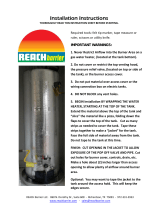
Water connections continued-
If this water heater is installed in a closed water supply system, such as the one
having a back-flow preventer in the cold water supply, provisions must be made to
control thermal expansion. DO NOT operate this water heater in a closed system
without provisions for controlling thermal expansion. Your water supplier or local
plumbing inspector should be contacted on how to control this situation After
installation of the water lines, open the main water supply valve and fill the water
heater. While the water heater is filling, open several hot water faucets to allow
air to escape from the water system. When a steady stream of water flows
through the faucets, close them and check all water connections for possible
leaks. NEVER OPERATE THE WATER HEATER WITHOUT FIRST BEING CERTAIN
IT IS FILLED WITH WATER.
WARNING
FAILURE TO INSTALL AND MAINTAIN A NEW, LISTED 3/4’’ X 3/4’’
TEMPERATURE AND PRESSURE RELIEF VALVE WILL RELEASE THE
MANUFACTURER FROM ANY CLAIM WHICH MIGHT RESULT FROM
EXCESSIVE TEMPERATURE AND PRESSURES.
For protection against excessive temperatures and pressure, install temperature
and pressure protective equipment required by local codes, but not less than a
combination temperature and pressure relief valve certified by a nationally
recognized testing laboratory that maintains periodic inspection of production of
listed equipment or materials as meeting the requirements of the Standard for
Relief Valves and Automatic Gas Shutoff Devices for Hot Water Supply Systems,
ANSI Z21.22 or the Standard CAN1-4.4. Temperature and Pressure and the
Standard CAN1-4.4, Temperature, Pressure, Temperature and Pressure Relief
Valves and Vacuum Relief Valves. The combination temperature and pressure
relief valve must be marked with a maximum set pressure not to exceed the
maximum working pressure of the water heater. The combination temperature
and pressure relief valve must also have an hourly rated temperature steam BTU
discharge capacity not less than the hourly rating of the water heater. Install the
combination temperature and pressure relief valve into the opening provided and
marked for this purpose on the water heater.
Note: Some models may already be equipped or supplied with a combination
temperature and pressure relief valve. Verify that the combination temperature
and pressure relief valve complies with local codes. If the combination
temperature and pressure relief valve does not comply with local codes, replace it
with one that does. Follow the installation instructions above on this page.
Install a discharge line so that water discharged from the combination temperature
and pressure relief valve will exit within six (6) inches (15.2 cm) above, or any
distance below the structural floor and cannot contact any live electrical part. The
discharge line is to be installed to allow for complete drainage of both the
combination temperature and pressure relief valve and the discharge line. The
discharge opening must not be subjected to blockage or freezing. DO NOT
thread, plug or cap the discharge line. It is recommended that a minimum
clearance of four (4) inches (10.2 cm) be provided on the side of the water heater
for servicing and maintenance of the combination temperature and pressure relief
valve. Do not place a valve between the combination temperature and pressure
relief valve and the tank.
WARNING




















